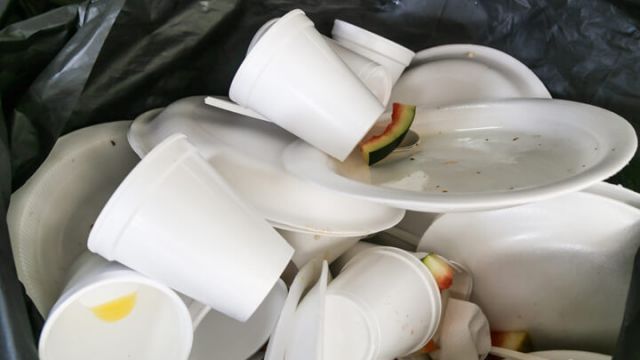
Remember that Styrofoam container your wanton soup came in? That Styrofoam is still Styrofoam and will take up space on this planet longer than you will. Non-biodegradable materials are used by people, usually just once, and then they sit in a landfill for hundreds, thousands, possibly millions of years.
We can’t say with complete certainty that all items are non-biodegrade, that is, that they’ll never get broken down by microorganisms and scattered about throughout the various nooks and crannies that make up an ecosystem. However, we do know these items release toxins into the environment, get into our waterways and become health hazards for people and wildlife while they sit in landfills.
Here are nine items that never decompose and what you can do with them instead.
1. Plastic bottles
Plastic bottles are made the way they are to keep liquid inside, but those same characteristics also make it a very difficult item to be broken down by microorganisms. The impact that plastic water bottles have on our ecosystems, most notably marine life, has led many to abandon their use. The best way to dispose of plastic bottles is to recycle them, but if you’re a sustainability expert you can build an entire house with them.
2. Glass bottles
Experts believe that given enough time, say a million years, glass will eventually biodegrade. But like their plastic cousins, glass bottles are designed not to break down in our lifetime. While glass is recyclable, care must be taken to ensure that it is recycled properly or a facility might deem it as trash and toss it in a landfill. It only takes one or two improperly recycled materials for a facility to decide that your bin lacks the recycling credibility they require and throw everything into the trash.
If the glass is broken, or if other items in your bin have caused your load to be labeled trash, then that glass is going in a landfill where it will stay for a mind-bendingly long time.
3. Ink cartridges
Ink cartridges from printers will take 450 to 1,000 years to breakdown, and they will leak harmful chemicals into the soil while they do it. Unfortunately, most ink cartridges are not accepted at recycling facilities.
Office supply stores, such as Home Depot or Staples, normally have store credit or rewards programs for people who bring in their used ink cartridges, and have options for refillable cartridges as well.
4. Plastic bags
A longtime enemy of environmentalists, plastic bags are estimated to take as long as 1,000 years to decompose. During that time, plastic ends up in the digestive systems of birds and other wildlife. Plastic bags are not likely to be collected as part of your curbside recycling program, but you may live near a drop-off center that does collect them. A list of drop-off locations can be found at plasticfilmrecycling.org. The best way to avoid putting plastic bags in landfills is to simply not use them. Instead, use reusable bags whenever possible.
5. Disposable diapers
Recycling centers are uninterested in receiving your child’s disposable diapers — they won’t even discuss it. Each disposable diaper contains numerous material (absorbent material, paper, plastic, whatever your child ate, etc.), which makes them difficult to be sorted at a recycling center.
Experts believe it can take as long as 500 years for disposable diapers to decompose. The idea of using single-use diapers in compost has been bandied about by many, but only few have dared to go down that road. A unique service by Tiny Tots includes the delivery and pick-up of single-use diapers to be recycled or composted in a high-grade facility. Not one diaper ends up in a landfill through the program.
6. Electronic waste
Throwing your old electronic appliances in the trash is bad for the planet and economically short-sighted. When old TVs, phones or gaming consoles are tossed into landfills they release cadmium, arsenic and lead into the ecosystem.
There are countless companies that will purchase your old electronics, even if it’s just for the parts. The best way to dispose of your e-waste is to take advantage of manufacturer’s recycling programs in stores like Staples, Home Depot or Best Buy.
7. Light bulbs
Compact fluorescent lamp (CFL) bulbs can be brought to recycling centers, unlike their less energy efficient cousins.
Many CFLs end up in landfills due to improper recycling of other items, leading the facility to deem the whole load as trash. If not recycled, these bulbs will leak mercury that could contaminate local ecosystems. It is recommended to bring all CFL bulbs to a recycling center to be sure they are disposed of properly.
8. Ziploc bags
Ziploc bags can be recycled through the same programs that recycle plastic bags but unfortunately most will still end up in landfills. Like plastic grocery bags, these sandwich-holding eco-offenders can take 1,000 years to decompose.
9. Styrofoam
Styrofoam is a material derived from fossil fuels that is made to never break down. It is one of the worst ideas humanity has ever had. Styrofoam floats, so it has accumulated along waterways all over the world, negatively impacting the health of wildlife.
Your curbside recycling program likely does not accept styrofoam, but check Home For Foam for a recycling program near you. As always, the most sustainable move is to avoid using it in the first place.
— Ian Carey

